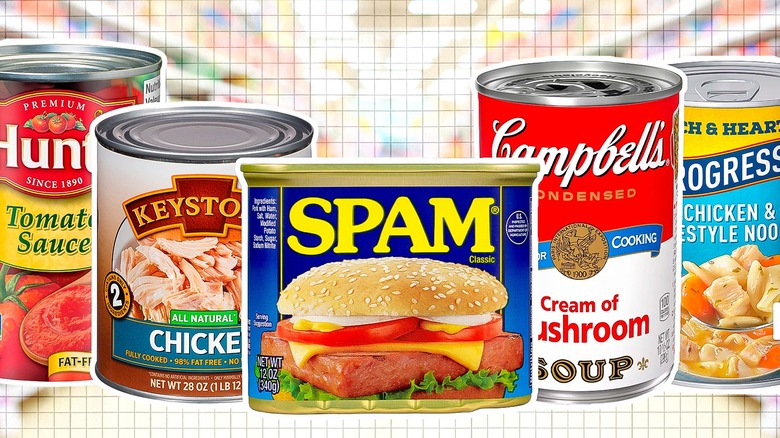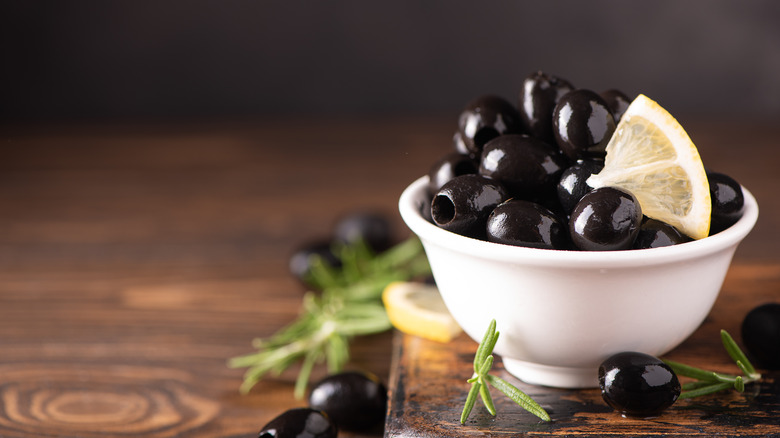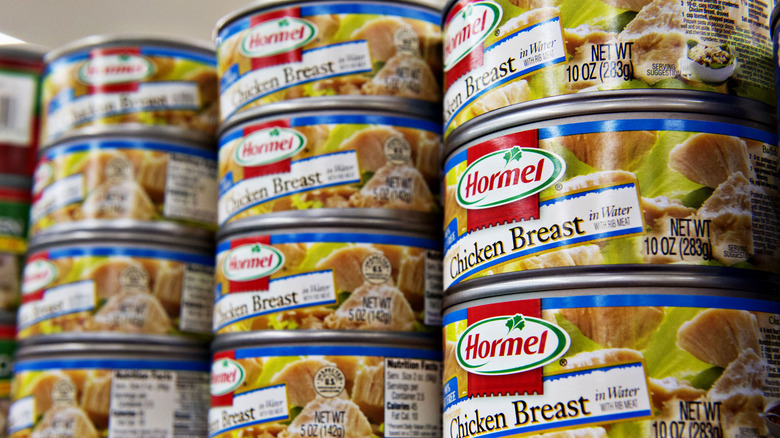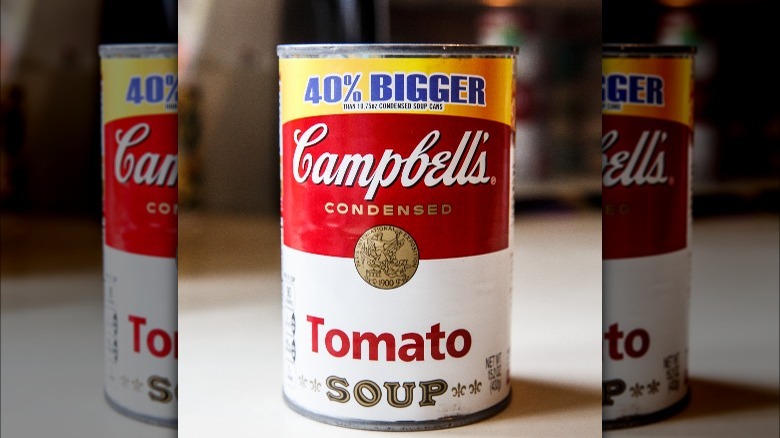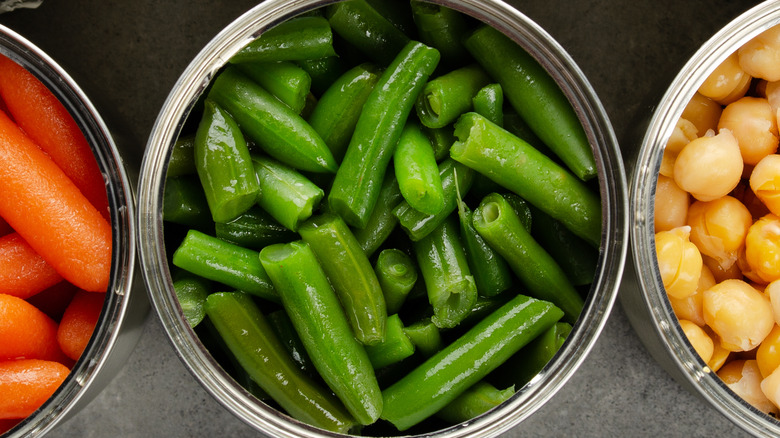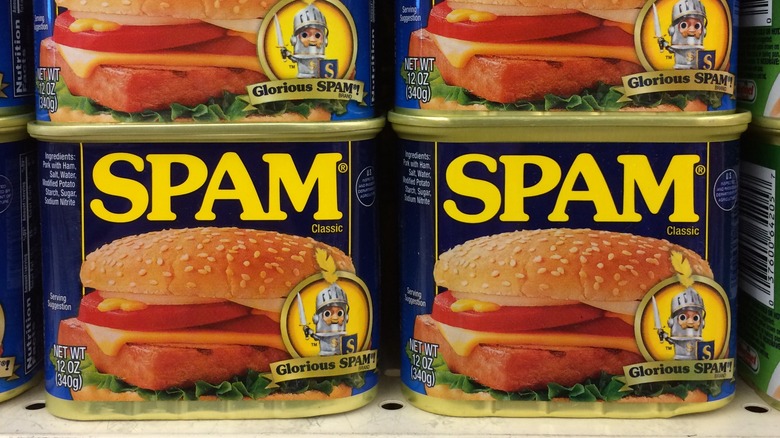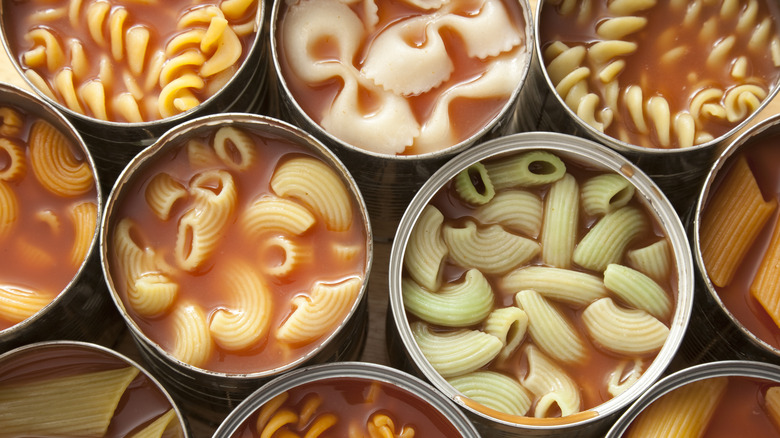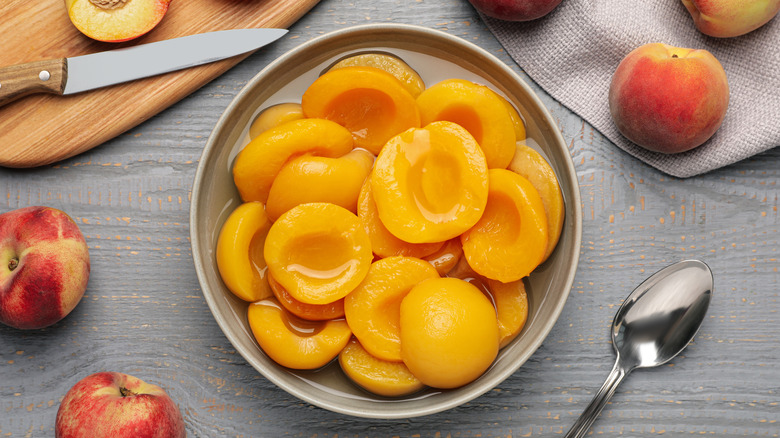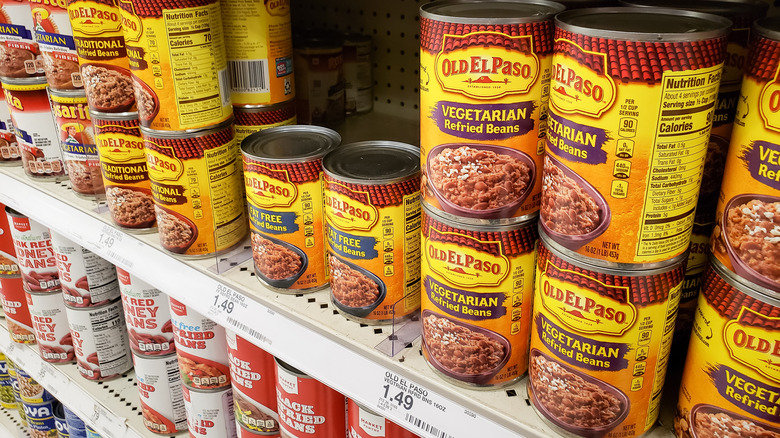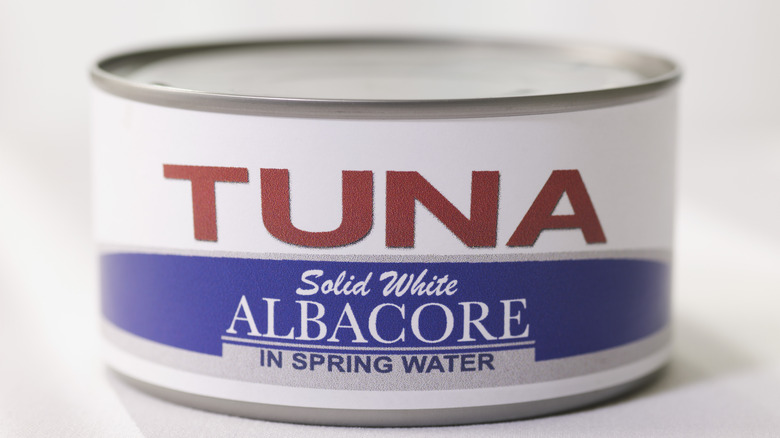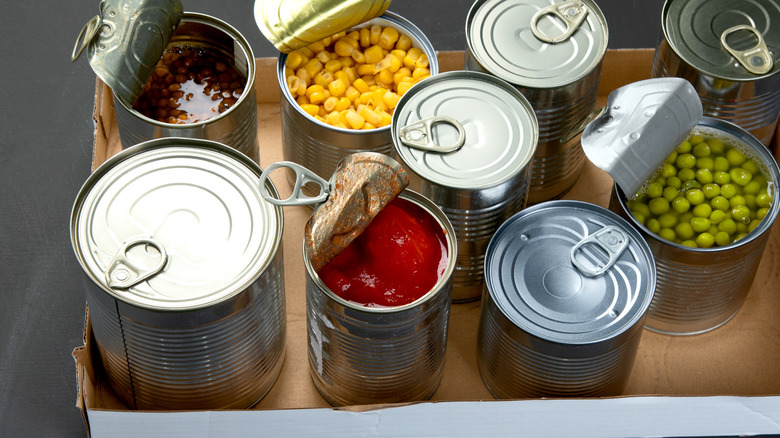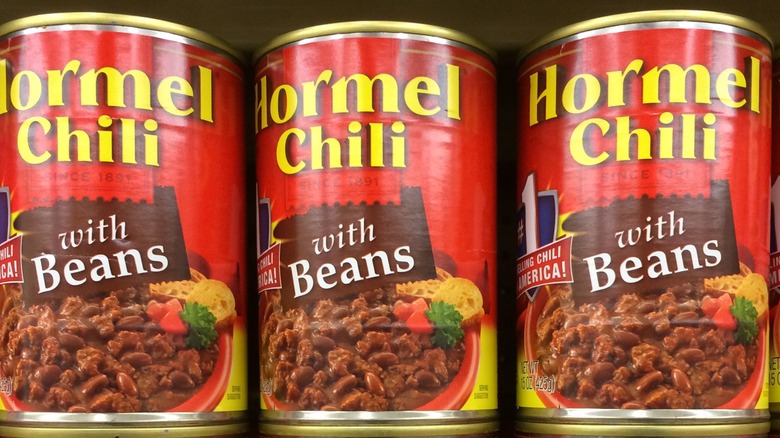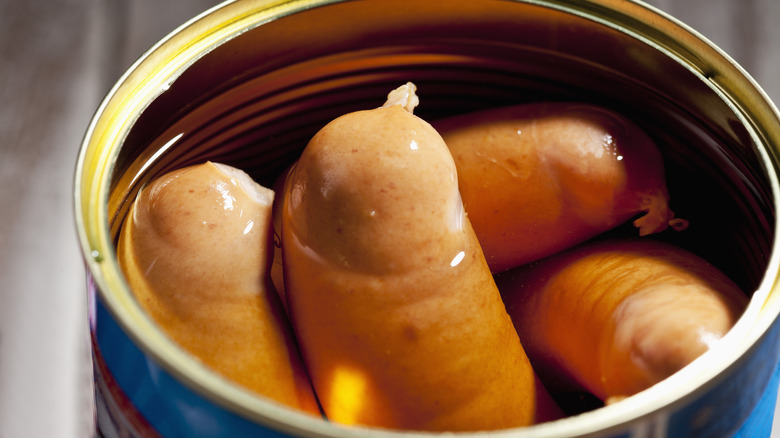12 Canned Foods You Should Avoid At The Grocery Store
It's no secret that canned foods are popular. Since its inception in the late 18th century, the process of canning foods to extend their lifespan has been a common method of preparation. And today, if you head into any grocery store or supermarket, you'll find shelf after shelf stacked high with identically-sized cans containing a dizzying selection of different types of foods.
With the size of the canned food market only set to get bigger and an estimated market value of over 25 billion dollars by 2033, according to Future Market Insights, it's clear that there's never been a better time to be in the canning game. But not all canned foods are created equal. While certain types of canned products can make a food taste better or take the hassle out of preparing it, other canned products may not be worth the hard-earned money you're spending on them. But when something's sealed in a metal can, invisible to the naked eye until you open it up in your kitchen, how can you tell what's worth spending your hard-earned cash on and what's not? We're here to give you the lowdown on all of the canned foods that are best left on the shelf.
1. Pitted olives
Olives are a firm favorite in the preserved product world, and in many ways, they're the ideal canned food. The natural flavors of olives pair perfectly with the salty brine they come packed in, making them even more delicious. But the type of canned olive you're picking will make a big difference to what you eventually eat. And if you're a fan of pitted olives, we advise that you look away now, as what you lose when those olive stones are taken out is a certain amount of quality.
The problem with pitted olives is that once you remove the stone, you leave them more susceptible to penetration from brine. This means that they can become soft faster than their unpitted counterparts, and you can end up with pretty mushy olives instead of having the firm, fleshy bite that makes the food so appealing. This may be a particular problem with sliced olives, which sport a greater surface area for the brine to soften. This increased brine action also creates another problem: Pitted olives can often end up tasting too salty and losing the mellow, complex flavor of the fruit. While pitting fresh olives can be a little more effort, what you lose in time, you get back in taste.
2. Chicken
Chicken isn't exactly a hard food to prepare, but with its tendency to become dry and stringy if cooked incorrectly, getting it just right can be tricky. So we can understand why pre-cooked canned chicken might seem like an easy, fuss-free alternative. In our opinion, though, you should steer clear of this food item entirely. Not only is canned chicken kind of weird, that jelly it comes in sort of gives us the ick but it's often made using animals that are raised inhumanely. "Much industrial chicken is raised in terrible conditions, and many have infections and are treated with antibiotics," explains certified nutritionist and celebrity chef Serena Poon to Eat This, Not That. "Antibiotic use in meat production is specifically connected to human health concerns such as antibiotic resistance and child development issues."
As well as these antibiotic considerations, cheaply-made canned chicken just doesn't taste as good as opting for an animal product coming from ethical sources. And there's also the versatility factor to consider: Canned chicken may be convenient for some meals, but buying raw chicken and making it from scratch means that you're able to marinade, flavor, and cook it however you like. In our opinion, you're better off leaving this chicken at the store and heading to the fresh meat aisle instead.
3. Soup
If you've ever bought a canned product in your life, there's a high likelihood that it was soup. Premade soups are some of the most popular items in the canned world, and with their ability to cut the prep time of a meal that can take hours to cook down to mere minutes, their desirability makes a lot of sense.
But a large number of canned soups have one thing in common, which makes them a bad choice at the grocery store; their sodium content. Some of the most well-known brands out there load their soups up with sodium to increase the flavor of their products, but this can make them into a salty meal that's somewhat lacking in nutrition. Just a half-cup serving of Campbell's Condensed Tomato Soup, for example, has 480 milligrams of sodium in it, which is over a fifth of the daily recommended limit in what is, let's be honest, a pretty small amount of soup. Other soups can be similarly salty and may also contain surprisingly high levels of fat or include preservatives that you'd rather not eat.
Naturally, though, not all canned soups are sodium-packed, and if you're craving a warm bowl of comfort, it's worth looking out for low-sodium options during your shopping trip. Try to grab a soup that's rich in fiber and packed with vegetables, and which has a good amount of protein in it, too.
4. Green vegetables
First things first: If you're grabbing cans of green vegetables from the shelf and putting them in your basket, we salute you. Your mom always said to eat your greens, and here you are, putting that into practice. Good for you. Unfortunately, though, those cans of pre-cooked broccoli, asparagus, and green beans may not be the best way for you to get your veggies due to the fact that they may not be as fresh or nutritious as if you bought them raw.
While canned vegetables are generally pretty beneficial for you and contain useful nutrients, the preparation method they undergo can sap them somewhat of the good stuff. Canned green vegetables are blanched before they're sealed in the can, and this intensive heating process can reduce the concentration of certain vitamins in the food. There's also the aesthetic factor of your food to consider. Green vegetables, and other foods, have a tendency to change color somewhat when they're canned, and this can stop them from being the vibrant green that makes them feel so fresh when you cook them from raw yourself. As well as this, while some green vegetables are packed in water and nothing more, others can have sodium included in them to help boost flavor, which again can make them a little less nutritious than you might like.
6. Spam
There are plenty of canned meats out there, but for many people, Spam is a cut above the rest. This slightly mysterious-looking pink meat is at home in fried rice as it is being eaten on its own, and its flavor-packed, easy-to-cook nature has made it a hit in houses around the world.
But while Spam may be a choice that customers keep coming back to, that doesn't mean that it's the best thing in the world to be eating. This meat product is absolutely loaded with sodium, with a mere two ounces of the stuff containing almost a third of your daily sodium allowance. Sodium-rich foods like Spam are especially risky as consuming too much sodium regularly can contribute to higher blood pressure, according to Healthline. As well as this, Spam is pretty high in fat and contains more fat than protein per serving, which might not be ideal if you're buying it to up your protein intake.
And, while Spam is definitely delicious, there's also no denying that it goes through a pretty high amount of processing. There's nothing inherently wrong with this, but let's be real; it kinda makes it a little less appealing than a regular cut of meat, right? And if you want something which actually looks like it came from an animal, you're far better off going for fresh meat that's been sustainably and ethically sourced.
7. Noodles
Things don't get much more convenient than canned noodles. Whether you're eating a can of Spaghetti-O's or a prepackaged chicken noodle soup, canned pasta and noodles are beloved by pretty much everyone for their ability to cut out any laborious cooking to enjoy a meal.
But honestly, folks, how difficult is it to cook noodles? There's definitely a time and a place for canned noodle products, but all too often, the noodles that are inside are mushy and gummy and leave you wanting more. Canned noodles are often way more cooked than pasta that's been freshly prepared, and this can mean its GI index ends up being higher, so you digest it quicker. When you cook pasta yourself, however, you can control how much you cook it, and preparing it, al dente means that it ends up being way more satisfying. It's also useful to bear in mind that while canned noodles may be convenient, they may not be that much cheaper than buying regular dried pasta. So if you're buying canned noodle products because of the cost, you may as well get the dried stuff and make it yourself.
8. Fruit in syrup
Canned fruit is a great way of getting a few portions of your five a day easily, even though it's arguably faster to simply grab a piece of fresh fruit and chow down. But despite seeming nutritious on the surface, once you get into that can, things can go downhill pretty quickly. Canned fruit comes in a variety of different styles, and many manufacturers pack their items in light or heavy syrup. While this definitely makes things sweeter, it also sends the sugar content in these apparently healthy products skyrocketing.
In one portion of Del Monte Pear Halves in heavy syrup, for example, there's a whopping 21 grams of sugar. And when you consider the fact that the recommended upper limit for added sugars each day is 37.5 grams for men and 25 grams for women, according to Healthline, that's an enormous amount coming from a source that's meant to be good for you. If you're looking to make your canned fruit choices more nutritious, it's best to seek out products that have no added sugar or that are packed in fruit juice. Alternatively, just grab some fresh fruit, and enjoy the natural flavors in all of their glory.
9. Refried beans
We've got to give it to the person who invented canned refried beans: They hit it out of the park. This ever-popular food item is a quick way to enjoy one of the most delicious dishes out there, and using canned refried beans cuts out the hassle of making them while still tasting pretty darn good.
But the problem with canned refried beans, along with certain other canned foods, is that no matter how good the brand you're buying is, it just won't stack up against a homemade recipe. There's something immensely fulfilling about making refried beans from scratch, and you're pretty much guaranteed a tastier end result. This is something that chef Ron Silver, owner of New York-based restaurant Bubby's, agrees with. "I tend to stay away from supplemental recipe canned goods," Silver says via Insider. "Dips, refried beans, and food that is processed into its final product for you," "I can make it better myself."
To boost their taste and make them last longer, canned refried beans can also be pretty salty. The average can of refried beans can contain almost 900 milligrams of sodium per cup serving. By making them at home, however, you can control the amount of sodium that goes into your food and create flavor through other means, such as with herbs and spices.
10. White tuna
It's no exaggeration to say that tuna is popular in the United States, with roughly 1 billion pounds of the fish eaten annually, according to the National Fisheries Institute. And of that amount, a large proportion is in canned form. There's an ease to canned tuna that's undeniable, and unlike some other canned foods, the fish retains its flavor and freshness excellently. But there's one glaring reason why you should reduce your canned tuna intake: The amount of mercury you could be ingesting.
White tuna is particularly problematic when it comes to mercury. This canned tuna type, most commonly sourced from albacore, can have almost triple the amount of mercury than other varieties. And eating too much mercury can cause some serious problems. Excessive mercury levels can affect multiple parts of your body negatively, including your kidneys, heart, and central nervous system, according to the Cleveland Clinic. In particularly severe cases, mercury poisoning can cause blindness, seizures, and even death.
While these symptoms often occur from long-term excessive exposure, it's always a good idea to limit your intake wherever possible — and cutting down on white tuna might be a good way to do it. Try to limit your white tuna portions to a maximum of three per month, and buy light tuna instead wherever possible.
11. Brine-packed vegetables
If you're packing vegetables onto your plate, it's pretty reasonable to expect that they'll be healthy. But that isn't always the case — especially if they've come out of a can. While some canned vegetable varieties are little more than just vegetables and water, others can be packed with additions that boost their flavor, like brine. Unfortunately, this boost to flavor can come at a cost.
By its very nature, brine is chock-full of sodium, what with being a solution of water and salt and all. And this sodium then infiltrates the vegetables, raising their sodium content as well. This can lead to innocuous-looking vegetables containing relatively high levels of sodium. Just a half-cup of Walmart's Great Value Mixed Vegetable Medley contains almost 300 milligrams of sodium, or 13% of the daily recommended amount for adults. This might not seem like a lot, but considering that it's coming in something that's meant to be a healthy side, it's not ideal.
The solution, though, is simple: Take a look at the label. These days, it's pretty easy to find low-sodium or no-sodium canned vegetable options in most major supermarkets. Alternatively, you could opt for frozen vegetables instead of canned, which usually don't have any sodium added, and are just as fresh.
12. Chili
Chili is pretty much the ultimate comfort food. And pretty much the only thing that's not comforting about it is having to make it. A good chili can take hours on the stove, and who has that kind of time in this day and age?
So, to cut down stress and maximize pleasure, it makes sense to grab a can of chili, pour it into a bowl, and zap it in a microwave. Regrettably, doing so might provide you with way more fat in your diet than you'd like. Certain types of canned chili are super-high in fats, and it's usually not the good, heart-healthy kind. Instead, canned chili manufacturers often load their products with saturated and trans fats, with some brands supplying almost a quarter of your daily saturated fat allowance in a half cup of food.
This may not be great news for your cholesterol levels, as too much-saturated fat may cause an increase in bad cholesterol, raising the chances of developing heart-related diseases, according to the NHS. Eating too many trans fats have a similar negative effect on your cholesterol. While looking for chili products that are low in saturated fats can be a great way to avoid this, we recommend making it yourself. We promise you it'll be even more comforting.
13. Canned sausages
There are a pretty incredible number of different sausages in the world, with a huge amount of countries having their own regional specialty. But sometimes, sausage burnout occurs, and you just want a reliable product that you know and love.
Enter the canned sausage. These cheap and cheerful products promise several flavorful sausages at a low price and are awesome for slicing up into salads or shoving in between buns. But canned sausages are, crucially, often ultra-processed meat products, and this can be slightly troublesome from a nutritional standpoint. Processed meat has been found to be particularly bad for your health. One study published in Critical Reviews in Food Science and Nutrition found that eating even 50 grams of processed meat daily can raise your chances of developing coronary heart disease by almost 20%. Excessive consumption of processed meat may also raise your risk of developing specific cancers, says the Harvard T. H. Chan School of Public Health.
Instead of buying canned sausages, it might be worth shelling out a few extra dollars and buying some freshly-made ones. While all sausages are, by their very definition, processed meat, a quality product is more likely to be made with good ingredients and free of any questionable preservatives.
